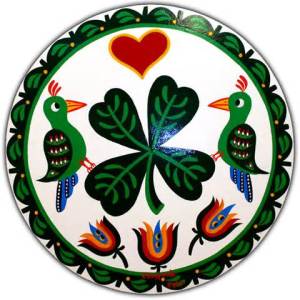Hex and Hex Signs
According to Wikipedia, a hex is “a magical spell, usually with a melevolent purpose, such as a curse”. We all know this. And, even if you are not pagan, you know some sort of way to offset a hex, you have a charm or amulet or lucky clover or you wear certain gemstones or your lucky shirt or carry a lucky penny. What fascinated me, when I started thinking about hexes, was a group of very seriously Christian folk who use pagan practices as part of their everyday life.
Early in the 20th century, these signs became a common sight on barns in Pennsylvania. Their simple folksy beauty became quite popular and their use spread. This type of art became well known all over the United States. I’m talking about the Hex Signs.
You’ve all seen them somewhere, particularly the distelfink. Distelfink is a German/Dutch word for goldfinch, a very common bird in this area. A distelfink in a hex sign is a symbol of good luck or good fortune.
So, who ARE the Pennsylvania Dutch? In the 19th century, and ending about 1863, a great influx of immigrants came to this country, not from Holland but from southwestern Germany, the Rhineland and Palatine areas, Baden-Wuttenberg, Alsatians, Swiss and even French Protestants. They came here seeking religious freedom. They spoke German or Deutsche and became known as the Plain Dutch (obviously a corruption of Deutsche. BTW, the German word for Germany is Deutschland). Plain Dutch differed from the more affluent Dutch (from Holland), who more easily assimilated themselves into mainstream America. Groups of these folk have become known as the Amish, Dunkers, Shakers and Mennnonites.
They live somewhat apart from others and have a closed society so not a whole lot is known about them.
Not much is known about their practices and beliefs outside of their own culture. They appear to be strict Christians who do not embrace “worldly” practices nor technology. If you look a bit closer, you will find that their folk magic is an integral part of their everyday lives. The tradition of Pow-wow goes back a long way into their past. Pow-wow is an Algonquin term and was borrowed from that native culture. For American natives, a pow-wow is a gathering of Indians and particularly medicie men.
For the Deutsche, the term pow-wow refers to a collection/study of European magic spells, folk remedies and recipes. The formulas mix Christian prayers, magic words and simple rituals to cure simple domestic ailments and rural troubles. The tradition is also called Speilwerk. (Hey, that looks suspiciously like “spellwork” to me) Its adepts are sometimes called hexenmeisters. The tradition of hex signs painted on Pennsylvania barns in rural areas is believed to relate to this tradition and some think the symbols for pentagrams were talismanic decorations.
The hex signs do have symbolic meanings. They were used to decorate indoors until the early 20th century Quilts and wooden household items were decorated with these designs to protect the home and hearth. When paint became more affordable, the decorations moved to the barns. After that, they became popular and now can be found even in jewelry items.
The nex daddy sign keeps away plague, famine and the evils of the world.
This hex sign uses both the distelfink and the Irish four leaf clover for luck and long life.
Pow-wow doctors use the Bible, the 6th and 7th books of Moses, a magical text which clams to be a sort of sequel to the biblical books of Moses, the Penteuch, and teh Egyptian Secrets of Albertus Magnus along with a book called the Long Lost Friend, (Der Lange Verborgene Freund, published 1820). An excerpt from the 6th and 7th books of Moses: ……….”.we must first become Christians before we can perform cures by Christian methods.” But some cures , expecially in the Urlasswe practice speak of deities such as Holle, Frost Giants, Wudan (Odin), Dunner (Thor), and Ewicher Yeeger (the Eternal Hunter).
Some cures, have a definite pagan resonance such as this charm for cataracts
Es Wassaer, des salz
Es Wasser,des salz
Des Salz iss am vergehne
glaarer binnich yetzs am sehne
Die Holle schteeht geeich yeder schaade
Kummt sie mir un heift mir graade
“the Water, the Salt
The Water, This Salt
The salt is ceasing to be
Clearer now do I see
Holle stands against every harm
she comes to me and helps me now
and pagan folk, how about this hex sign, the Eternal Oak which stands for strength in body and mind….remind you of the Oak King?
I know this isn’t strictly a pagan post but I did think it was interesting that folks we think are SO very different from us have roots in the very same pagan belief systems that we do.










